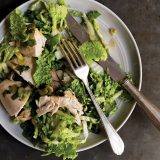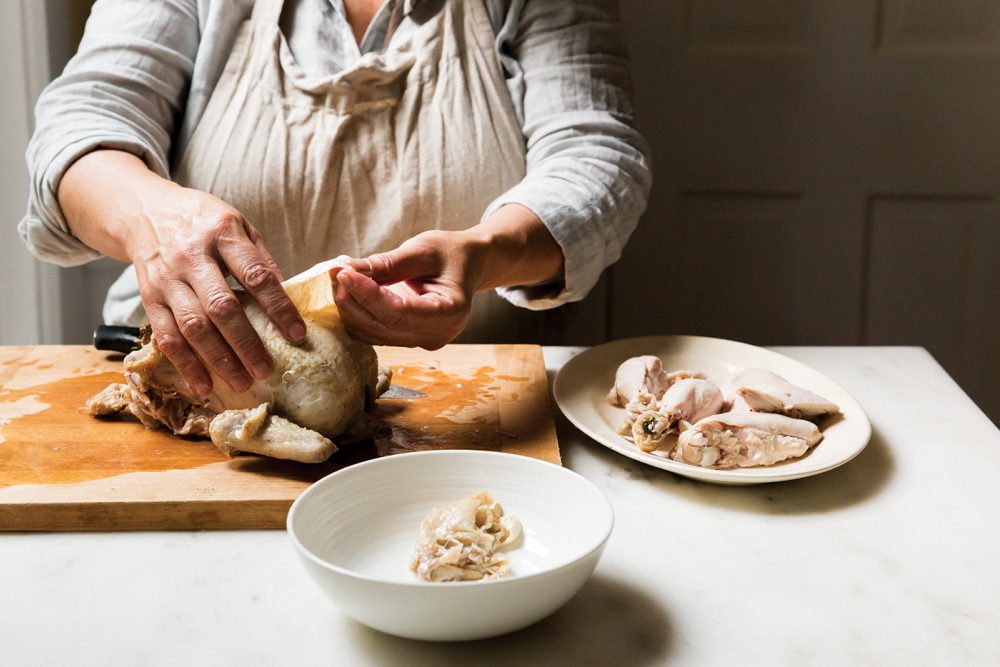Milk Street Chinese White Cooked Chicken With Ginger Soy Dressing
In Guangzho, they know that the simplest way to cook a chicken also is the best
White-Cooked Chicken Gets Big Flavor from a Long, Hot Bath


Forget the skin. It's the meat that matters.
Photos: Kristin Teig
This article is currently free. Become a member to get full digital access to everything milk street. Learn More.

Americans obsess over the skin
But the meat is what matters. Chinese-style poaching guarantees perfect, effortless results every time.
We denigrate chicken meat as the epitome of bland and instead lavish attention on its exterior, hoping an herbed rotisserie treatment or spicy wings or convection-crisped skin will somehow transcend our expectations. And then we're disappointed yet again.
Turns out it doesn't have to be that hard.
The Chinese long ago sussed out that chicken is a lot better when flavor is more than skin deep. Hence their tradition of whole-bird poaching, which delivers simple, clear flavors and a silky, tender-but-firm meat primed for a variety of vibrant sauces. Known as "white-cooked chicken" or "white cut," the classic Cantonese dish gets its name from the fact that the meat is simmered without soy sauce and therefore remains white. Some recipes call for plain cooking water, others add flavorings such as ginger and scallions.
Once cooked, the bird is cut up and served with simple but flavorful sauces, such as soy, oyster or chili sauces seasoned with fresh ginger or ground chilies. And in contrast to roasting, it's much more difficult to overcook the chicken. Poaching delivers heat evenly, so dry breasts and pink thighs aren't an issue. The whole process takes about the same amount of time as roasting, most of it hands-off. In fact, the last 30 minutes of cooking occur off the heat entirely.
As for the skin? None in this game. Poaching results in blond skin that most Americans will want to discard (though Chinese cooks usually leave it on and consider it tasty).
White-cooked chicken traditionally is served cold or at room temperature, usually cut horizontally across the bones to produce even chunks for dipping. Of course, it's easily adapted to American tastes. We liked it served hot, carved into legs, wings and breasts, with sauces.
While the poached chicken cools before carving, use the hot seasoned broth to cook rice to round out the meal. Use the broth 1:1 for any water called for by the variety of rice you use. For long-grain white rice, for example, combine 1½ cups rinsed rice with 2 cups of the broth. Bring to a simmer, then reduce to low, cover and cook until the rice is fluffy and tender, 15 to 18 minutes. And be sure to save any remaining broth for use in rice, soups, sauces and braises. We freeze it in 2-cup portions in zip-close freezer bags.
Though popular in Asia, poaching—which is done between 160°F and 185°F, not at boiling—is mostly out of favor in the U.S. When it's done at all, it's usually with pieces of meat, not whole birds. But across Asia (variations of this dish appear throughout the region) whole birds symbolize prosperity and family unity and often are part of Lunar New Year feasting.
A similar state of affairs existed in America for the 200 years prior to the 1950s. Chicken was a special-occasion meat mostly purchased and prepared whole. Only in the latter half of the 20th century did a chicken become less than the sum of its parts due to a growing distaste for the unglamorous bits.
As ever, the quality of the meat makes a difference. Battery-raised supermarket birds usually are chilled in a cold water bath after cleaning, which can result in soggy meat. Air-chilled birds are firmer, and a free-range air-chilled bird will have the firmest and most flavorful meat but also the highest price tag. Roaming charges, if you will.
Related Recipes
-
Chinese White-Cooked Chicken with Ginger-Soy Dressing
See Recipe
Source: https://www.177milkstreet.com/2016/11/white-cooked-chicken-gets-big-flavor-from-a-long-hot-bath
0 Response to "Milk Street Chinese White Cooked Chicken With Ginger Soy Dressing"
Post a Comment